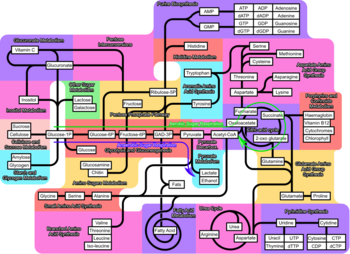 |
| Metabolic pathways wikiproject. (Photo credit: Wikipedia) |
IUBMB-Sigma-Nicholson Metabolic Pathway Charts | Sigma-Aldrich
Dr. Donald Nicholson 1916–2012 Dr. Donald Nicholson received his B.Sc. in 1936 and his Ph.D in 1940, both in Chemistry from London University. He then went to work at Boots Pure Drug Company at Nottingham on the development and production of the earliest sulphonamide antibacterial drugs. In 1946 he joined the department of Bacteriology at the School of Medicine in Leeds as an I.C.I Fellow in Chemotherapy and remained there as Lecturer or Senior Lecturer in Microbiology until "retirement" in 1981. Even into his 90s, Dr. Nicholson was actively engaged in the creation of smaller and more detailed "minimaps" and especially "animaps". In recognition of his work, he received an Honorary D.Sc. and was made one of only two Honorary Life Members of the IUBMB. Learn more about Dr. Nicholson and how he created the Metabolic Pathway Charts. The Metabolic Pathways Map contains over 500 hyperlinks to Sigma product listings.
More links:
1. Interactive Metabolic Pathways Map | Sigma-Aldrich (Gmaps based)

2. Roche Biochemical Pathways - ExPASy
Digitized version of wall charts courtesy Boehringer Mannheim et al, divided into Metabolic Pathways and Cellular and Molecular Processes.
In biochemistry, a metabolic pathway is a series of chemical reactions occurring within a cell. The reactants, products, and intermediates of an enzymatic reaction are known as metabolites. In a pathway, the reactant is modified by a sequence of chemical reactions. These reactions are catalyzed by enzymes, where the product of one enzyme acts as the substrate for the next. These enzymes often require dietary minerals, vitamins, and other cofactors to function.
In biochemistry, a metabolic pathway is a series of chemical reactions occurring within a cell. The reactants, products, and intermediates of an enzymatic reaction are known as metabolites. In a pathway, the reactant is modified by a sequence of chemical reactions. These reactions are catalyzed by enzymes, where the product of one enzyme acts as the substrate for the next. These enzymes often require dietary minerals, vitamins, and other cofactors to function.











